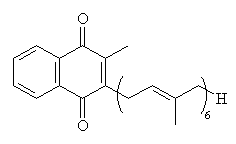
Vitamin K
Structure:
The chemical structure of vitamin K is shown in 2D below:
Function:
Vitamin K is essential for normal blood clotting. The Recommended Daily Amount (RDA) of vitamin K for men is 120µg and 90µg for women. The safe upper limit for vitamin K has not been determined as no adverse effects due to overconsumptionhave been recorded. The lack of vitamin K may lead to bone disease, including osteoporosis.
Mechanism:
Vitamin K is essential for the synthesis of prothrombin, a precursor of
thrombin, which is the enzyme that converts fibrinogen into fibrin. Fibrin is the main
constituent of the blood clot that seals over recent vein and artery injuries to prevent
infection.
A vitamin K-dependent carboxylation converts glutamate residues on prothrombin, which are
weak chelators of Ca2+, into gamma-carboxyglutamate, a much stronger chelator.
The binding of Ca2+ by prothrombin anchors it to the phospholipid membranes
derived from blood platlets following injury. This binding of prothrombin brings it into
close contact with two enzymes which regulate its conversion into thrombin, which can then
activate fibrinogen in the plasma to fill the breach.
Sources:
Vitamin K is found in green leafy vegetables.
Fascinating Fact: To prevent excessive clotting after an operation the vitamin K antagonist, Warfarin (rat poison) is administered in carefully controlled doses.